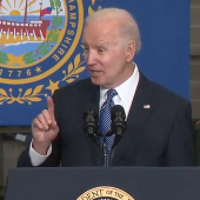Biden’s Deficit Spin

In recent speeches, President Joe Biden has been misleadingly taking credit for cutting federal deficits by historic amounts, though most of the reduction in deficits is the result of expiring emergency pandemic spending. Deficits fell between fiscal year 2020 and 2021 far less than initially projected after Biden added to them with more emergency pandemic and infrastructure spending.
And the deficits under Biden and beyond are projected to remain historically high compared with pre-pandemic levels.
In recent remarks, Biden took credit for cutting the deficit by $350 billion in FY 2021 and claimed his proposed budget for FY 2022 will cut the deficit by $1.3 trillion this year.
“You know, the budget I submitted — my first budget that passed and became law, it cut the federal deficit by $350 billion,” Biden said in a speech on April 19. “We cut the deficit $350 billion. And the budget I proposed this year, if it comes to total fruition, it will cut the deficit by 1 trillion 300 billion dollars. So when my Republican friends start talking about ‘big spenders’ and the reason why there’s inflation, take a look. Take a look. We’ve cut the deficit drastically. … Last year, as I said, we cut the deficit by more than 350 thousa- — billion dollars. This year, we’re on track for $1.3 trillion in cuts. And look, that would be the largest debt reduction in American history.”
“Don’t listen to my Republican friends in Congress — last year, we reduced — my budget reduced the — the deficit by $350 billion,” Biden said in a speech in Portland, Oregon, on April 21. “You hear me? We didn’t spend — we didn’t increase the deficit a penny. We reduced it by $350 billion.”
In February 2021, shortly after Biden took office and before any of Biden’s fiscal policies were enacted, the nonpartisan Congressional Budget Office projected a federal budget deficit of about $2.3 trillion in 2021, $874 billion less than the shortfall recorded in 2020. It projected deficits to fall again to a $1.1 trillion deficit in FY 2022 — meaning another $1.2 trillion reduction in the deficit from 2021. Combined, the deficits in FY 2021 and FY 2022 were expected to total $3.3 trillion. Those projections assumed no new changes in federal law.
But on March 11, 2021, Biden signed the American Rescue Plan into law. The new emergency pandemic relief law included, among other things, increased child care tax credits, extended unemployment payments, small-business support and $1,400 checks to qualifying Americans. The law cost an estimated $1.9 trillion over 10 years.
Fast forward to July, when the CBO was able to take into account the new spending approved by Biden. Instead of an $874 billion drop in deficits between 2020 and 2021, the deficit was then projected to drop just $126 billion — from $3.13 trillion to $3 trillion. Moreover, the combined deficits for 2021 and 2022 were projected to total nearly $4.2 trillion — $842 billion more than the February forecast.
“It’s pretty silly,” Marc Goldwein, senior vice president and senior policy director at the Committee for a Responsible Federal Budget, said of Biden’s deficit-cutting claims. “He [Biden] didn’t cut the deficit, he increased it.”
“They are taking credit for the fact that deficits fell in 2021-2022,” Goldwein said. “If they had done nothing, deficits would have fallen by $1 trillion. They fell by much less than they were going to.”
We should also note that while Biden credited “the budget I submitted” last year for reducing deficits, the FY 2022 budget Biden proposed in May 2021 did not become law. As we have explained in the past, president’s budgets are largely symbolic statements of priorities, not legislation on which Congress actually votes.
“Congress never did pass anything like Biden’s budget,” Howard Gleckman, a senior fellow in the Urban-Brookings Tax Policy Center, told us via email. Congress “did finally pass an omnibus appropriations bill half way through the fiscal year,” he said. “But it funded most programs at prior year levels plus a small bump, and included none of Biden’s ambitious tax increases.”
Ultimately, CBO said FY 2021 ended with a deficit of nearly $2.8 trillion—about $360 billion less than the deficit in 2020. That’s similar to the $350 billion figure Biden uses. CBO noted that the deficit for 2021 ended up smaller than it had projected in July “mostly because income tax receipts were greater than CBO projected.”
CBO said greater-than-expected revenue growth in 2021 was due to “strong growth in economic activity, following the substantial disruption in 2020 caused by the pandemic.” CBO credited, in part, “legislation enacted in response to the pandemic.”
“As a share of GDP, which is really the way to look at this, deficits would decline from 12.4 of GDP in 2021 to 5.8 percent this year to 4.5 percent next year,” Gleckman said. “But most of that action is due to two factors: The booming economy that is likely to increase revenues substantially and a sharp decline in pandemic-related spending/tax cuts.
“I suppose Biden gets some credit for this since he and the [Democrats in Congress] designed the American Rescue Plan to include temporary spending,” Gleckman said. “But it is not as if this year’s budget includes major spending reductions. In fact, many of his proposals would increase spending.”
In a fact sheet on the president’s proposed 2023 budget, the White House boasted about “the President’s strategy to grow the economy from the bottom up and the middle out and his effective management of the American Rescue Plan—a strategy that was built on smart, fiscally prudent investments that helped jumpstart our economy.”
However, in an April 8 blog post titled “No, President Biden Has Not Implemented Historic Deficit Reduction,” CRFB wrote (with this emphasis) that “the main source of falling deficits is the expiration of most COVID relief such as enhanced unemployment benefits and recovery rebates. The remaining decrease is largely the result of strong income growth and high inflation.” CRFB also noted that even after this post-pandemic drop, deficits will remain historically high.
“The President’s actions to date have not reduced deficits but instead increased them,” CRFB wrote. “Between the American Rescue Plan, the bipartisan infrastructure law, and various executive orders, we estimate at least $2.5 trillion has been added to deficits through 2031 over the President’s term so far.”
Jon Huntley, senior economist at the Penn Wharton Budget Model, agreed that the deficit reduction is mostly due to expiring pandemic spending by the federal government.
“The decline in the deficit between fiscal years 2021 and 2022 was largely expected,” Huntley told us via email. “As the Committee for a Responsible Federal Budget notes, deficits were forecast to decline by about $1.4 trillion dollars from 2021 to 2022. The 2021 Congressional Budget Office (CBO) Long-Term Budget Outlook highlights the reason for this decline: Under current law, a huge amount of mandatory spending was scheduled to expire in 2022. Therefore, the federal deficit was going to decline under currently law. Congress would have needed to explicitly pass an extension of these mandatory spending programs to maintain 2021-levels of federal spending. As no such extension passed, spending declined in excess of a trillion dollars in fiscal year 2022.”
A Penn Wharton Budget Model analysis of Biden’s proposed FY 2023 federal budget — which includes more federal spending but also new revenues such as higher taxes on high-income earners — concluded that it would reduce government debt in the first decade (relative to current law, meaning the law without Biden’s budget being enacted) according to a conventional “static” forecast. That’s relatively in line with the White House projecting that its budget would cut deficits by more than $1 trillion over 10 years.
In a “dynamic” analysis — which includes economic feedback that takes into account a projected reduction in the workforce tied to the proposed child tax credits — PWBM projected a 2.1% increase in the federal debt over the next 10 years (relative to current law), but a 1.7% reduction in government debt by 2050.
Biden’s proposed budget assumes passage of most of what was in Biden’s Build Back Better plan, which would increase government spending on public health, education, housing, crime prevention and other programs, but would be offset, in part, by new taxes on high-income and high-wealth households.
The Build Back Better bill stalled after Democratic Sen. Joe Manchin announced in December that he would not support it. But Biden since has said that he is confident Congress can pass pieces of the Build Back Better agenda. Sens. Manchin and Kyrsten Sinema, the Democratic holdouts who effectively killed the legislation last year, are reportedly unwilling to revisit the bill this year.
Editor’s note: FactCheck.org does not accept advertising. We rely on grants and individual donations from people like you. Please consider a donation. Credit card donations may be made through our “Donate” page. If you prefer to give by check, send to: FactCheck.org, Annenberg Public Policy Center, 202 S. 36th St., Philadelphia, PA 19104.
This article has been archived for your research. The original version from FactCheck.org can be found here.


